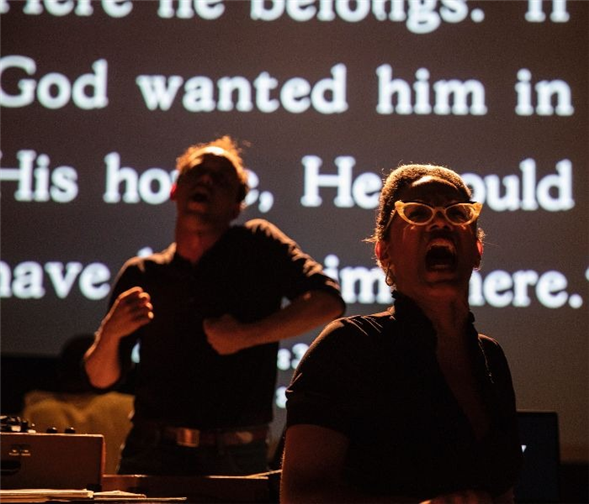Translate Page

Why two theatre artists are reclaiming the infamous 1927 film
---
Although it was once considered a classic and remade twice, the original Jazz Singer is rarely seen these days. While the 1927 film broke cinematic ground as the first feature with synchronized sound, it's now best remembered as that movie with Al Jolson doing blackface. It's the rags-to-riches tale of Jakie Rabinowitz, a Lower East Side Jewish boy who is cast out by his family after choosing to become a jazz singer instead of a cantor. The character makes his triumphant Broadway debut singing "Mammy" in blackface. By 2019 standards, the film and its star should be cancelled.
But is there something to be gained from parsing The Jazz Singer today, especially the parts that make us uncomfortable? Film buffs Joshua William Gelb and Nehemiah Luckett think so, and they've done just that with a theatrical exploration of the film called jazz singer, which kicks off a three-week run at Abrons Arts Center on September 24.
"This is a narrative that is steeped in the lore of Yom Kippur, the Jewish day of atonement," says Gelb, a director, writer and performer who co-conceived this world premiere with composer-performer Luckett. "We're trying to explore the mistakes that were made in the past and the ones that we might be making now for the future." To do that, Gelb, who is Jewish, and Luckett, who is African American, have created a multimedia concert-style production, with the cast examining the various aspects of black and Jewish identity that are referenced in the film.
Luckett and Gelb started collaborating on the project two years ago and have mounted several developmental workshops. In this iteration, the audience sees the show coming together in real time, which is meant to mirror improvisation in jazz. Luckett has composed an original score that fuses Jewish cantorial music, ragtime and jazz, and different guest musicians will join him every night throughout the run.
"Even though the film is called The Jazz Singer, it doesn't have any actual jazz music," says Luckett. "As close as they do get to incorporating some elements of ragtime, they are missing some key ones. It's more influenced by musical theatre and Tin Pan Alley."
The lack of jazz in the movie speaks to the absence of black voices in its creation. That's a jumping off point for the cast to explore the state of black and Jewish relations at the time.
At the outset, Gelb is alone onstage when the idea for the production comes to him. His character examines what it means to be Jewish, but not practice Judaism. In between talking and songs, voice-overs of other texts play, including excerpts from Henry Ford's anti-Semitic "The International Jew" pamphlets, and poems from Langston Hughes' Fine Clothes to the Jew.
"That distance between your heritage and how you decide to identify was always really interesting to me, particularly in the setting of the Lower East Side," says Gelb. "The area has transformed from being a tenement, a Jewish ghetto, to having a whole different influx of immigrants, to becoming so gentrified these days. I thought [Abrons Arts Center, which is located in the neighborhood] was the right space to start investigating this story."
Next, Luckett comes into the piece, offering a perspective on the inclusion of blackface and the appropriation of African-American culture in the film. Later, a black woman named Tracey (played by Cristina Pitter) and jazz musicians arrive and weigh in as scenes are projected behind them. Eventually, they start to quote and reenact sections of the movie but with more woke dialogue.
"I had never seen The Jazz Singer before working on this show, and after watching it I was surprised at how little blackface there was," says Luckett. "It's an immigrant story and the story of an artist who is struggling with his identity. Blackface is in no way important to the plot."
While Luckett and Gelb aren't blackface apologists, they are less interested in indicting the film or Jolson, but rather in conjuring the parts of the story that get lost in today's cancel culture. The 92-year-old movie touches on complex and timely issues such as immigration, assimilation and identity, so in many ways, this project is an attempt at restorative history. They even commissioned Brooklyn-based artist Jarrett Key, who paints canvases with his dreadlocks, to create the poster art.
"You don't have to have seen The Jazz Singer or be a jazz lover to experience this show," says Gelb. "We're hoping that our audiences will walk away both challenged and incited to talk."
---
TDF MEMBERS: At press time, discount tickets were available for jazz singer. Go here to browse our current offers.
Follow Kelundra Smith at @PieceofKay. Follow TDF at @TDFNYC.
Top image: Joshua William Gelb and Tracey Conyer Lee in a developmental workshop of jazz singer. Photos by Maria Baranova.